Header Image from National Park Service Crater Lake National Park, Oregon.
Oregon was admitted to the U.S. on February 14, 1859 as the 33rd state.
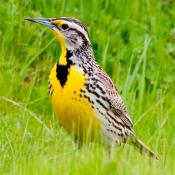 Bird: Western Meadowlark – The western meadowlark is a member of the blackbird family. A male usually has two mates at the same time. The females do all the incubation and brooding, and most of the feeding of the young. State bird of Kansas, Oregon, Nebraska, Wyoming, North Dakota, and Montana
Bird: Western Meadowlark – The western meadowlark is a member of the blackbird family. A male usually has two mates at the same time. The females do all the incubation and brooding, and most of the feeding of the young. State bird of Kansas, Oregon, Nebraska, Wyoming, North Dakota, and Montana
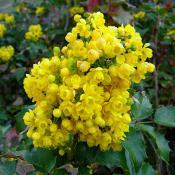 Flower: Oregon grape-flower – The flowers, borne in dense clusters in late spring, are yellow, and are followed by spherical dark dusty blue berries, which give rise to the common name “Oregon grape”. The inner bark of the larger stems and roots of Oregon-grape yields a yellow dye; the berries give purple dye.
Flower: Oregon grape-flower – The flowers, borne in dense clusters in late spring, are yellow, and are followed by spherical dark dusty blue berries, which give rise to the common name “Oregon grape”. The inner bark of the larger stems and roots of Oregon-grape yields a yellow dye; the berries give purple dye.
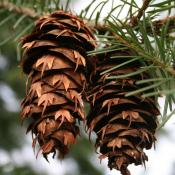 Tree: Douglas fir. – At 329 feet the Coast Douglas-Fir in Oregon is considered the tallest tree in the state. Also known as the Douglas Spruce or the Oregon Pine tree. Because of the massive size of the tree, the wood or lumber from the tree is highly valued. It is used for lumber and plywood and also makes excellent wood fuel.
Tree: Douglas fir. – At 329 feet the Coast Douglas-Fir in Oregon is considered the tallest tree in the state. Also known as the Douglas Spruce or the Oregon Pine tree. Because of the massive size of the tree, the wood or lumber from the tree is highly valued. It is used for lumber and plywood and also makes excellent wood fuel.
State Quarter
From theus50.com
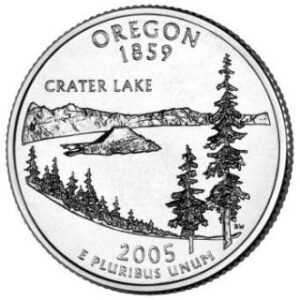
On February 14, 1859, Oregon became the 33rd state to be admitted into the Union. Its coin design features a portion of Crater Lake, the deepest lake in the United States, viewed from the south-southwest rim. The design incorporates Wizard Island, as well as Watchman and Hillman Peaks on the lake’s rim and conifers. The coin bears the inscription “Crater Lake”.
Crater Lake is a unique and stunning natural treasure, formed more than 7,700 years ago by the collapse of Mt. Mazama in what is now southern Oregon. At 1,949 feet, it is the deepest lake in the United States and the seventh deepest in the world, and has a record clarity depth of 134 feet. The main cause of Crater Lake’s remarkable clarity is its isolation from incoming streams and rivers.
Capital: Salem, Oregon
Nickname: Beaver State
Motto: The Union
State Nut: The hazelnut, also known as the filbert. Oregon grows 99 percent of all hazelnuts produced in the United States.
State Colors: Navy blue and gold
State Fish: The Chinook salmon
Oregon Facts and Trivia
Oregon is the 9th largest state covering 98,381 square miles; 360 miles long (N-S) and 400 miles wide (W-E).
The origin of Oregon may be the most hotly debated of the state names. Here’s a few of the competing explanations (and I may have even missed a few):
- – Derived from the French ouragan (“hurricane”) and the state named so because French explorers called the Columbia River le fleuve aux ouragans (“Hurricane River”) due to the strong winds in the Columbia Gorge.
- – Derived from oolighan, a Chinook name for the eulachon (Thaleichthys pacificus), a smelt found along the Pacific coast and prized as a source of food for Native Americans in the area.
- – Derived from the Spanish orejón (“big ears”), which early Spanish explorers reportedly used to refer to local natives.
- – Derived from Ouragon, a word used by Major Robert Rogers in a 1765 petition asking the British government to finance and supply an overland search for the Northwest Passage. As to where Rogers got the word, it could have come from an error on a French-made map from the early 1700s, where the Ouisiconsink (“Wisconsin River”) is misspelled “Ouaricon-sint,” and broken so “Ouaricon” sits on a line by itself or it might have been derived from the Algonquian wauregan or olighin, which both mean “good and beautiful” (and were both used in reference to the Ohio River at the time).
- – Derived from the Shoshone words Ogwa (river) and Pe-On (west) and picked up from the Sioux, who referred to the Columbia as the “River of the West,” according to American explorer Jonathan Carver.
The Willamette River was discovered in 1792.
American Captain Robert Gray explored the Columbia River in 1792, naming it after his ship.
Following exploration by the Spanish and French, in the 17th and 18th centuries, Oregon was mapped by the Lewis and Clark expedition in their search for the Northwest Passage.
A treaty between the United States and Spain established the current southern border between Oregon and California. The treaty was signed in 1819.
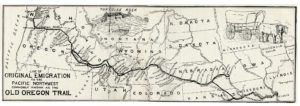 Starting in the 1830s, many groups of pioneers traveled to the area on the famous Oregon Trail, and the U.S. began joint settlement of the area with the United Kingdom. The Oregon Trail is the longest of the overland routes used in the westward expansion of the United States.
Starting in the 1830s, many groups of pioneers traveled to the area on the famous Oregon Trail, and the U.S. began joint settlement of the area with the United Kingdom. The Oregon Trail is the longest of the overland routes used in the westward expansion of the United States.
In 1846, the border between U.S. and British territory was formally established at the 49th parallel – the part of the territory that was given to Britain would ultimately become part of Canada.
The Oregon Territory was established in 1848. It was a large territory that included the future states of Oregon, Idaho, Washington, and part of Montana. As Oregon continued to grow it eventually broke off from the other regions in the territory.
In 1858 the richest gold find in the Cascade Mountains was discovered in the Bohemia Mining District at Sharp’s Creek near Cottage Grove.
When gold was discovered in the 1850s, even more people moved into Oregon. There was less and less land for the Native Americans. Tribes such as the Nez Perce were forced to move into smaller and smaller reservations. In 1863, gold was discovered on the Nez Perce reservation. They were told they would have to move again. After a small fight erupted in 1877, the Nez Perce under the leadership of Chief Joseph tried to flee to Canada. The U.S. army pursued them. They fought the army all along the way, engaging in several battles along their 1,400 mile retreat. These battles are called the Nez Perce War. In the end, the Nez Perce lost and were forced to move to Indian Territory in Oklahoma.
Discovered in 1874 the caves located in Oregon Caves National Monument are carved within solid marble.
In 1880 a sea cave was discovered near what is now known as Florence. Sea Lion Caves is known to be the largest sea cave in the world.
Oregon’s state flag pictures a beaver on its reverse side. It is the only state flag to carry two separate designs.
Oregon has more ghost towns than any other state.
The Columbia River gorge is considered by many to be the best place in the world for windsurfing.
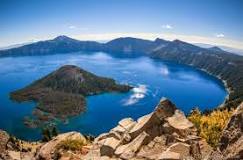 Crater Lake is the deepest lake in the United States and is formed in the remains of an ancient volcano.
Crater Lake is the deepest lake in the United States and is formed in the remains of an ancient volcano.
Oregon and New Jersey are the only states without self-serve gas stations.
Eugene was the first city to have one-way streets.
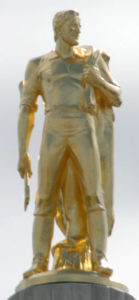 The “Oregon Pioneer” statue that tops the capitol building is a work by Ulric Ellerhusen. This heroic figure represents the spirit of Oregon’s early settlers.
The “Oregon Pioneer” statue that tops the capitol building is a work by Ulric Ellerhusen. This heroic figure represents the spirit of Oregon’s early settlers.
There are nine lighthouses standing along the coastline. Five are still being used; the others are designated historic monuments. The nation’s most photographed lighthouse is the Heceta Head Lighthouse located in Lane County.
The Tillamook Rock Lighthouse, built in 1880, is currently used as the site of the final resting place of up to 467,000 cremated individuals.
Portland is known as The City of Roses. High above the city the International Rose Test Garden features more than 500 varieties of roses cultivated continuously since 1917.
At 11,239 feet Mount Hood stands as the tallest peak in Oregon. It is a dormant volcano.
Tillamook is home to Oregon’s largest cheese factory.
Florence is known as Oregon’s rhododendron capital.
The Columbia River forms most of the northern border between Oregon and Washington. The Snake River forms over half of the eastern boundary with Idaho.
In 1905 the largest long cabin in the world was built in Portland to honor the Lewis and Clark expedition.
Strange laws:
It’s Illegal To Use canned corn as fishing bait
It’s Illegal To Own A Pet Reptile (Unless You’re A School Or City) in Springfeild
In Portland, It’s Illegal To Get Married At A Roller Rink
In Portland, It’s Also Illegal To Wear Roller Skates In A Bathroom
You May Not Whistle Underwater In Portland
It’s Illegal To Walk Down The Street With Untied Shoes In Portland
Babies may not be carried on the running boards of cars.
Drivers may not pump their own gas.
A door on a car may not be left open longer than necessary.
An adult may not show a minor any piece of classical artwork which depicts sexual excitement.
When Oregon entered the Union in 1859 — it did so as a “whites-only” state. The original state constitution banned slavery, but also excluded nonwhites from living there.
Music:
“Land of Oregon” (state song)
“Coming Home (Oregon)” by Mat Kearney –
“Live Long In Oregon” Laura Gibson
“Lumberjack” by Johnny Cash
“Oregon Trail” by Woody Guthrie
“Portland Town” by Joan Baez
People:
- Garner Ted Armstrong, evangelist
- James Beard, food expert
- Beverly Cleary, author of the “Ramona” books for children
- Matt Groening, cartoonist of the “Simpsons”
- Tonya Harding, iceskater
- Howard Hesseman, actor (Dr. Johnny Fever on WKRP in Cincinnati)
- River Phoenix, actor
 Jane Powell, actress, singer
Jane Powell, actress, singer- Doc Severinsen, band leader
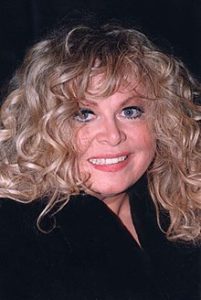 Sally Struthers, actress
Sally Struthers, actress
Credits:
See Mental Floss.com
See History.com
See Wattpad.com
See Only In Your State.com
See Ducksters.com
See 50 States.com
See Tidbits of History/states for facts and trivia about each of the states.

Pingback: This day in history, February 14